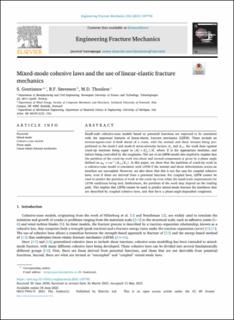| dc.contributor.author | Goutianos, Stergios | |
| dc.contributor.author | Sørensen, B. F. | |
| dc.contributor.author | Thouless, M. D. | |
| dc.date.accessioned | 2021-10-21T08:05:20Z | |
| dc.date.available | 2021-10-21T08:05:20Z | |
| dc.date.created | 2021-06-22T09:06:42Z | |
| dc.date.issued | 2021 | |
| dc.identifier.citation | Engineering Fracture Mechanics. 2021, 252, . | en_US |
| dc.identifier.issn | 0013-7944 | |
| dc.identifier.uri | https://hdl.handle.net/11250/2824367 | |
| dc.description.abstract | Small-scale cohesive-zone models based on potential functions are expected to be consistent with the important features of linear-elastic fracture mechanics (LEFM). These include an inverse-square-root -field ahead of a crack, with the normal and shear stresses being proportional to the mode-I and mode-II stress-intensity factors, and , the work done against crack-tip tractions being equal to , where is the appropriate modulus, and failure being controlled by the toughness. The use of an LEFM model also implicitly implies that the partition of the crack-tip work into shear and normal components is given by a phase angle defined as . In this paper, we show that the partition of crack-tip work in a cohesive-zone model is consistent with LEFM if the normal and shear deformations across an interface are uncoupled. However, we also show that this is not the case for coupled cohesive laws, even if these are derived from a potential function. For coupled laws, LEFM cannot be used to predict the partition of work at the crack tip even when the small-scale requirements for LEFM conditions being met; furthermore, the partition of the work may depend on the loading path. This implies that LEFM cannot be used to predict mixed-mode fracture for interfaces that are described by coupled cohesive laws, and that have a phase-angle-dependent toughness. | en_US |
| dc.language.iso | eng | en_US |
| dc.publisher | Elsevier Science | en_US |
| dc.rights | Navngivelse 4.0 Internasjonal | * |
| dc.rights.uri | http://creativecommons.org/licenses/by/4.0/deed.no | * |
| dc.title | Mixed-mode cohesive laws and the use of linear-elastic fracture mechanics | en_US |
| dc.type | Peer reviewed | en_US |
| dc.type | Journal article | en_US |
| dc.description.version | publishedVersion | en_US |
| dc.source.pagenumber | 17 | en_US |
| dc.source.volume | 252 | en_US |
| dc.source.journal | Engineering Fracture Mechanics | en_US |
| dc.identifier.doi | 10.1016/j.engfracmech.2021.107792 | |
| dc.identifier.cristin | 1917560 | |
| dc.source.articlenumber | 107792 | en_US |
| cristin.ispublished | true | |
| cristin.fulltext | original | |
| cristin.qualitycode | 1 | |

